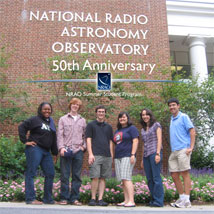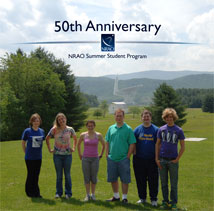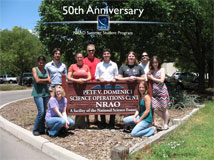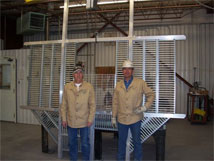NRAO eNews
November 2009 • Vol. 2, Iss. 11
- Upcoming Events
- ALMA Detects Sub-millimeter Fringes
- Opportunities for Undergraduate Students, Graduating Seniors, & Graduate Students
- Synthesis Imaging Workshop
- New Mexico Symposium: First Announcement
- EVLA Antenna Component Production
- VLBA Observations Using Phase Referencing
- Under the Radar: The First Woman in Radio Astronomy, Ruby Payne-Scott
- Charles Eric Knapp, 1956-2009
- Career Opportunities
- Recent NRAO News Releases
NRAO eNews: November 2009 • Volume 2, Issue 11

Upcoming Events
 NRAO Town Hall at the American Astronomical Society Meeting
NRAO Town Hall at the American Astronomical Society Meeting
January 5, 2010 | 6:30 - 8:30 PM | Washington, DC
Washington Marriott Wardman Park | Thurgood Marshall Ballroom North
 New Mexico Symposium
New Mexico Symposium
January 15, 2010 | Socorro, NM
 Jansky Lecture
Jansky Lecture
January 15, 2010 | Socorro, NM
 NRAO Proposal Deadline
NRAO Proposal Deadline
February 1, 2010 5:00 PM EST
 SKA2010 - International SKA Science and Engineering Meeting
SKA2010 - International SKA Science and Engineering Meeting
March 22–25, 2010 | Manchester, UK
 12th Synthesis Imaging Workshop NRAO & New Mexico Tech
12th Synthesis Imaging Workshop NRAO & New Mexico Tech
June 8–15, 2010 | Socorro, NM
ALMA Detects Sub-millimeter Fringes
Al Wootten
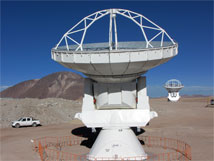
Figure 1. Two ALMA antennas have measured fringes at three frequency bands at the 5000m elevation ALMA Array Operations Site.
On 23 September, the first ALMA antenna was delivered to the 5000m Array Operations Site (AOS). It was joined on 16 October by a second antenna which was placed on pad 109; on 17 October the first antenna was moved from its location near the Technical Building to pad 96, about 160 meters away. Shortly afterward connections to the rest of the ALMA system had been made and by 21 October fringes were detected toward the Orion SiO maser and 3C84 at 3mm wavelength. Similar success was also soon achieved at 230 GHz (Band 6) and at 345 GHz. Many people contributed to this effort that was led by Robert Lucas with Tzu-Chiang Shen, Rodrigo Araya, Rodrigo Olguin, Juan Pablo Caram, and Antonio Hales; many others contributed to this success, on a course charted by the Assembly, Integration and Verification, Commissioning and Science Verification, and Science Operations teams. Project Scientist Richard Hills noted "Although all of the components that make up the integrated ALMA telescope are thoroughly tested prior to being sent to the AOS, the coherent detection of these sources from the high site using all of the combined equipment represents a unique test of the system as a whole. This successful operation means that many of the problems associated with getting cutting-edge technology working in such harsh conditions have been solved. We are very much looking forward to adding the third antenna which will allow us to verify more of the software and hardware by obtaining phase closure." (Further information on the fringe acquisition)
A third ALMA antenna is expected to join the first two by Thanksgiving as the fledgling array grows. Concrete has been poured for all of the 192 antenna stations that ALMA requires. After initial testing, the focus of early interferometry in 2010 will move to the compact cluster of stations near the center of the array.

A recent view from the holography tower shows the Operations Support Facility. Notable are the Alcatel antennas in the left foreground. Several antennas may be seen in various stages; dummy front end and back end racks have now been fit into the receiver cabins as an early test. Note that the carbon fiber backup structure arrives in two halves (far left) which are then glued together in one of the building in the foreground. On the right, several antennas are under test at the Operations Support Facility Technical Building.
Meanwhile new equipment continues to arrive and march through its tests at the lower-elevation ALMA Operations Support Facility (OSF). The third and fourth North American antennas have now been accepted there, and two additional antennas should be accepted in December. The first of the 7m antennas has completed its journey from Japan and is now awaiting assembly at the Mitsubishi area of the OSF. Several antennas in the European antenna (Alcatel) area will be undergoing receiver cabin tests, including equipping them with dummy receiver and signal processing equipment.
Opportunities for Undergraduate Students, Graduating Seniors, & Graduate Students
Jeff Mangum, NRAO Student Programs Coordinator
NRAO is accepting applications for the 2010 NRAO Summer Student Research Assistantships program. Each summer student conducts research under the supervision of an NRAO staff member at one of the NRAO sites, on a project in the supervisor’s area of expertise. The project may involve any aspect of astronomy, including original research, instrumentation, telescope design, or astronomical software development. Examples of past summer student research projects are available on the Summer Student website.
Supervisors choose their own student candidates from the received applications, and the site to which a summer student is assigned depends on the location of the NRAO supervisor who chose them. Students are encouraged to review the NRAO staff web pages to learn more about the types of research being conducted at the NRAO. On their application, students may request to work with a specific staff member, to work on a specific scientific topic, or to work at a specific site.
The program runs 10-12 weeks each summer, from early June through early August. At the end of the summer, participants present their research results in a student seminar and submit a written report. These projects often result in publications in scientific journals. Financial support is available for students to present their summer research at an American Astronomical Society meeting, generally at the winter meeting following their appointment.
Besides their research, students take part in other activities, including multiple social events and excursions, and an extensive lecture series that covers various aspects of radio astronomy and astronomical research. Students also collaborate on their own observational projects using the VLA, VLBA, and/or GBT.
There are three types of Summer Student programs available at the NRAO.
The NRAO Research Experiences for Undergraduates (REU) program is for undergraduates who are citizens or permanent residents of the United States or its possessions, and is funded by the National Science Foundation (NSF) Research Experiences for Undergraduates (REU) program.
The NRAO Undergraduate Summer Student Research Assistantship program is for undergraduate students or graduating college seniors who are U.S. citizens, are from an accredited U.S. Undergraduate Program, or otherwise eligible to work in the U.S. This program primarily supports students or research projects that do not meet the REU guidelines, such as graduating college seniors, some foreign undergraduate students, or projects involving pure engineering or computer programming.
The NRAO Graduate Summer Student Research Assistantship program is for graduate students who are citizens or permanent residents of the United States or its possessions, enrolled in an accredited U.S. Graduate Program, or otherwise eligible to work in the U.S.
The stipends for the 2010 Summer Student Program will be $592 per week for undergraduates and graduating seniors, and $634 per week for graduate students. These stipends include an allowance for housing, since housing is not provided.
Students who are interested in Astronomy and have a background in Astronomy, Physics, Engineering, Computer Science, and/or Math are preferred. The same online application form and application process is used for all three programs. Required application materials include an on-line application form (including a statement of interest), official transcripts, and three letters of recommendation. The deadline for receipt of application materials is Monday, 1 February, 2010.
Synthesis Imaging Workshop
Amy Mioduszewski
The 12th Synthesis Imaging Workshop will be held June 8-15, 2010 at the NRAO and New Mexico Institute of Mining and Technology in Socorro, NM. The Workshop will comprise a week of lectures on aperture synthesis theory and techniques at a level appropriate for graduate students in astrophysics. The Workshop will also include two days of practical tutorials demonstrating data collection, calibration, and imaging of various types of data, including new data from the EVLA and VLBA, and a millimeter/submillimeter wavelength dataset. More information on scheduled lectures and events is available online. If you are interested in receiving more information about the workshop, please pre-register on the same web page. A formal first announcement will be distributed in early 2010.
New Mexico Symposium: First Announcement
Amy Mioduszewski
The NRAO and the New Mexico Institute of Mining and Technology (NMT) will jointly host the 25th annual New Mexico Symposium on 15 January 2010 at the NRAO Science Operations Center in Socorro, NM. We expect to fill a full day with oral and poster presentations, beginning at 09:00 and continuing through 17:30.
The 44th Karl G. Jansky Lecture will be presented by Dr. Anthony Readhead at the Symposium. In the evening, Dr. Readhead will also give a public lecture on NMT campus. The NRAO will host a dinner for registered Symposium participants prior to the public lecture.
Astronomers from New Mexico and surrounding states are invited to attend the Symposium and, if they wish, to present a paper. We particularly encourage students and early career astronomers to use the Symposium as a forum to present ongoing astronomical research. We can accommodate ~ 15 oral presentations and a large number of posters.
There is no registration fee, but anyone planning to attend is asked to register by January 4 to facilitate planning.
The meeting web page contains a link to the registration form, and also includes details about oral and poster presentations, the Jansky Lecture, and Socorro-area information, such as maps and restaurants.
Please distribute this announcement at your institution, to reach as wide an audience as possible. If you are interested in attending and did not receive this message by direct e-mail, we would be glad to add your email address to our Symposium information list. E-mail addresses and requests for further information should be sent to lappel@aoc.nrao.edu.
EVLA Antenna Component Production
Jim Ruff
It has been a long road, but we are nearing the end of EVLA antenna component production. This photo shows Tommy Montoya and Adrian Zamora of the VLA Weld Shop with the last EVLA feed cone floor, #28. The last feed cone will not be made for a while yet, but the end is in sight!
VLBA Observations Using Phase Referencing
Joan Wrobel

Figure 1. More than 2700 science observations were made with the VLBA during 2003-2008. On average, 63 percent of those observations used phase referencing.
Phase-referenced VLBA observations offer two critical advantages over pure self-calibration techniques: (1) weaker target sources can be observed because the array's effective coherence time is increased from minutes to hours, vastly increasing the number of accessible target sources; and (2) the target source position can be measured accurately relative to the phase reference source. This second advantage permits registration of VLBA images with those from other facilities, as well as registration of VLBA movie frames that span days to years. Such VLBA movies yield information on proper motions, annual parallaxes and/or orbital motions.
What percentage of VLBA observations employ phase referencing? A total of 2773 science observations were made with the VLBA during 2003-2008. Associated with each observation is a summary file created by Sched, the NRAO scheduling software. Information from the summary file yields the number of scans scheduled per hour during the observation. To follow the effects of the dynamic ionosphere and/or troposphere, rapid switching between the reference source and the target source is required. This leads to 20 or more scans per hour for a phase-referenced observation. In contrast, an observation that will rely on self-calibration will have less than 20 scans per hour. A break point of 20 scans per hour was tested by visually inspecting all observations during several months. This break point failed for observations at 86 GHz and for observations involving in-beam phase referencing; such cases currently represent a negligible fraction of all observations.
Using 20 or more scans per hour as the break point, it is a simple matter to use awk to find the percentage of observations employing phase referencing. The figure shows this percentage year by year. On average, 63 % of VLBA observations during 2003-2008 used phase referencing. This enormous popularity stems from the two critical advantages mentioned above, as well as an end-to-end implementation of phase referencing on the VLBA. Key aspects of this implementation were community led, most notably the development of and operational support for precision geodesy and astrometry on the VLBA by NASA and the USNO (Petrov et al. 2009, Journal of Geodesy, 83, 859; arXiv:0806.0167v2).
Under the Radar: The First Woman in Radio Astronomy, Ruby Payne-Scott
Miller Goss
 Miller Goss (NRAO) and Richard X. McGee (CSIRO, retired) are pleased to announce the publication of “Under the Radar: The First Woman in Radio Astronomy, Ruby Payne-Scott” as a book in Springer’s Astrophysics and Space Science Library series. The book is also available as an e-book to institutions that have a Springer e-book subscription, and it will be launched at Sydney University on 25 November 2009. The book has 354 pages and 120 figures. Institutions that have a Springer subcription in the US and Canada can purchase a softcover edition at a substantial discount.
Miller Goss (NRAO) and Richard X. McGee (CSIRO, retired) are pleased to announce the publication of “Under the Radar: The First Woman in Radio Astronomy, Ruby Payne-Scott” as a book in Springer’s Astrophysics and Space Science Library series. The book is also available as an e-book to institutions that have a Springer e-book subscription, and it will be launched at Sydney University on 25 November 2009. The book has 354 pages and 120 figures. Institutions that have a Springer subcription in the US and Canada can purchase a softcover edition at a substantial discount.
Payne-Scott (1912-1981) was an eminent Australian scientist who made major contributions to the World War II radar effort of the Council for Scientific and Industrial Research (1926-1949) Division of Radiophysics from 1941 to 1945. In late 1945, she began pioneering radio astronomy efforts at Dover Heights in Sydney and continued her groundbreaking activities until 1951. Payne-Scott most probably carried out the first interferometer observations in radio astronomy at sunrise, 26 January 1946 at Dover Heights, using an Australian Army radar as a radio telescope. A ‘sea-cliff’ interferometer was used at an eastern facing 100-meter cliff at Dover Heights, Sydney.
Payne-Scott made remarkable contributions to the theory of radio interferometry and collaborated with Joseph Pawsey in the first formulation of the concept of aperture synthesis in mid 1946. She was also an active collaborator with B.Y. Mills, Chris (W.N.) Christiansen, Alec Little and John Bolton. A well-known image of Payne-Scott along with Little and Christiansen is in Figure 1(Chris is to the right). This image was taken in about 1950 at the Potts Hill Reservoir field station in Sydney; Payne-Scott and Little developed the first swept lobe interferometer to follow the motions of solar radio bursts of Type II and Type IV at 100 MHz. Payne-Scott played the key role in elucidating the properties of the ubiquitous Type III solar radio bursts; from the short time delays observed (high frequencies observed initially, lower frequencies later), she inferred the slightly relativistic velocities of the exciters of these events in the solar corona.
The book also summarizes the conflicts that Payne-Scott had with the CSIRO hierarchy due to the fact that she was a woman. She was in conflict the CSIRO administration when her marriage from 1944 was discovered in 1950. Payne-Scott left CSIRO when her son was born in late 1951. She also protested the wage inequality of women in the post World War II era. Other aspects of her life that are described are her membership in the Communist Party of Australia, her passion for bush walking and the success of her two famous children. The authors have attempted to place her scientific achievements and the discrimination she faced in a modern context.
Charles Eric Knapp, 1956-2009

We inform you with great sadness that Eric Knapp lost his two-year long battle with lymphoma on October 29, 2009. Eric was hired by NRAO as one of the original Green Bank Telescope operators in 1998. As an amateur astronomer, Eric made contributions to several American Association of Variable Star Observers programs and also to supernova search collaborations. Eric was always eager to learn about the projects that were observing on the GBT while he was an operator. His passion for astronomy even led him to start a collaboration that successfully observed with the GBT (GBT05B-045, Searching for Pulsars in the Newly Discovered Globular Cluster GLIMPSE-CO1). Eric's enthusiasm, easy-going personality and dedication to his job always made observing with him as the GBT operator a fun experience. The numerous acknowledgements to Eric in journal articles are a testimony to how well he was respected by the astronomical community. The Greenbrier Valley Astronomical Association has established a memorial fund in Eric's honor that will be used for astronomy education. If you would like to send a personal message to the family, please contact Pete Chestnut.
Career Opportunities
New Postings
Software Engineer II (CASA): The National Radio Astronomy Observatory is seeking a Software Engineer II for their Common Astronomy Software Applications (CASA) division in Socorro, New Mexico. Astronomers and programmers from US, Europe, Canada, Japan, and Chile are actively developing and using CASA. There are several Qt based applications that will need to be extended and supported by the Software Engineer.
Software Engineer III: The National Radio Astronomy Observatory in Socorro, NM is seeking a skilled developer to participate in the development of the observation scheduling and pipeline data-reduction subsystems. The successful candidate will display a strong working knowledge of Java and of object-oriented analysis and design. The ability to learn new computer techniques (languages, methodologies, etc.) quickly and independently is required. Excellent software technical documentation skills are required.
ALMA Commissioning Scientists: The Joint ALMA Office invites applications for the position of Commissioning Scientists to be based in Santiago, Chile. The role of ALMA Commissioning Scientists is to assist the Project Scientist and Deputy Project Scientist in planning and executing the scientific commissioning of ALMA.
NRAO Postdoctoral Fellow: The North American ALMA Science Center (NAASC) invites applications for a Postdoctoral Fellow to work with the Joint ALMA Observatory (JAO) scientific staff as it gears up for the commissioning and validation of ALMA. Primary focus will be on assisting the Commissioning Team in planning and executing the scientific commissioning of ALMA at its location in Santiago, Chile.
Senior RF Engineer: The Atacama Large Millimeter/submillimeter Array (ALMA) in San Pedro de Atacama, Chile seeks a Senior RF Engineer for the Electronics Group with the Department of Technical Services. Responsibilities will be vital to the setup and early operations of the Electronics Group and will require extensive RF knowledge and experience as it supports highly complex and newly commissioned ALMA Front end Electronics. We are still waiting on Roland for his edits so it will not be on the web until Monday.
Assistant Scientist A (ALMA Science Operations Astronomers): The Joint Atacama Large Millimeter/submillimeter Array (ALMA) Office invites applications for the position of Science Operations Astronomer, based primarily in the ALMA offices in Santiago, Chile. The successful candidates will support the Commissioning and Science Verification team, assisting the Project Scientist in planning and executing the scientific commissioning of ALMA before ALMA early science operations (2011) and will participate in tests and evaluations of the ALMA control software and software tools for science operations, and in the planning of science operations.
Telescope Operator: The National Radio Astronomy Observatory Robert C. Byrd Green Telescope (GBT) in Green Bank, WV seeks a Telescope Operator to monitor and operate one or more telescopes and assist engineers and technicians in diagnosing telescope equipment failures.
Systems Administrator II: The North American ALMA Science Center (NAASC) is seeking a Systems Administrator II to support science users accessing archive, high performance computing and storage systems to support their data analysis needs. This Unix system administrator will also evaluate, deploy and maintain the hardware and software systems providing these services, as well as supporting the day-to-day technical needs of users in a highly dynamic science research environment.Research Associates (Postdoctoral Scholars): The North America ALMA Science Center (NAASC) is inviting applications for one or two Postdoctoral Scholars at its headquarters in Charlottesville, Virginia to work with the S4G (Spitzer Survey of Stellar Structure in Galaxies) team. The S4G is designed to be the ultimate legacy survey for the distribution of stellar structure in the nearby universe. For more information on the S4G, visit http://web.ipac.caltech.edu/~kartik/s4goverview.pdf
Science Writer: The National Radio Astronomy Observatory in Charlottesville, Virginia is recruiting a Science Writer. Working In collaboration with observatory scientific, technical, and media design staff, the Science Writer will research, plan, and write articles and multimedia/video scripts for web pages, exhibits, and media programs that communicate scientific and technical concepts to science-attentive public audiences (including students).
Assistant Scientist/A: The team of scientists at the Green Bank Telescope (GBT) is seeking an Assistant Scientist/A to provide full scientific support to the GBT and the NRAO. Responsibilities will include supporting observers who use the telescope as well as working on a diverse variety of projects, which may include the development and commissioning of new instrumentation on the telescope, working with the engineering staff to improve the overall telescope performance, and aiding with the data reduction pipelines needed for the GBT. The position will be filled at the assistant, associate, or scientist level, depending on experience.
NRAO Postdoctoral Fellow: The North American ALMA Science Center (NAASC) invites applications for a Postdoctoral Fellow to work with the NAASC scientific staff. The focus will primarily be on independent research, with an emphasis on exercising ALMA end-to-end software and databases from a scientific perspective, in particular the Splatalogue spectral line database.
Scientists (NAASC): The North American ALMA Science Center (NAASC) seeks applicants with research interests in areas related to the goals of ALMA to join its User Support staff. They will provide advanced scientific and technical support to members of the North American ALMA community, and will have the opportunity to pursue a vigorous and independent research program. These positions will be filled at the assistant, associate, or scientist level, commensurate with experience.
Software Engineer II: The Software Development Division in Green Bank, WV is seeking a Software Engineer to help design, develop, implement, and support the Dynamic Scheduling System for the Green Bank Telescope. The Dynamic Scheduling System is broken into three major components: a web application built with the Django web development framework, a series of custom user interfaces built with Ext GWT, and the core scheduler implemented in the functional programming language, Haskell. The Dynamic Scheduling team uses agile software development methods and automated unit testing to provide a working system for sponsors at every step of system development.
Software Engineer III: The Software Development Division in Green Bank, WV, is seeking a Software Engineer to provide support for the scientists who use the Green Bank Telescope (GBT). Work will be directed initially toward improvements in the post-observing data analysis and reduction software as well as developing data reduction and analysis software infrastructure for existing instrumentation.
Systems Engineer: The Atacama Large Millimeter Array (ALMA) is currently seeking a Systems Engineer at its headquarters in Charlottesville, Virginia, to work as part of the System Engineering team participating in equipment acceptance, planning system requirement verifications, maintaining system sensitivity, reviewing test results and populating those results to the available budget.
Recent NRAO News Releases
 Oct. 28: Blast from the Past Gives Clues About Early Universe
Oct. 28: Blast from the Past Gives Clues About Early Universe
Astronomers using the National Science Foundation's Very Large Array (VLA) radio telescope have gained tantalizing insights into the nature of the most distant object ever observed in the Universe -- a gigantic stellar explosion known as a Gamma Ray Burst (GRB).
 Nov. 16: Record-Breaking Radio Astronomy Project to Measure Sky with Extreme Precision
Nov. 16: Record-Breaking Radio Astronomy Project to Measure Sky with Extreme Precision
Astronomers will tie together the largest collection of the world's radio telescopes ever assembled to work as a single observing tool in a project aimed at improving the precision of the reference frame scientists use to measure positions in the sky. The National Science Foundation's Very Long Baseline Array (VLBA) will be a key part of the project, which is coordinated by the International VLBI Service for Geodesy and Astrometry.
 Zoom
Zoom